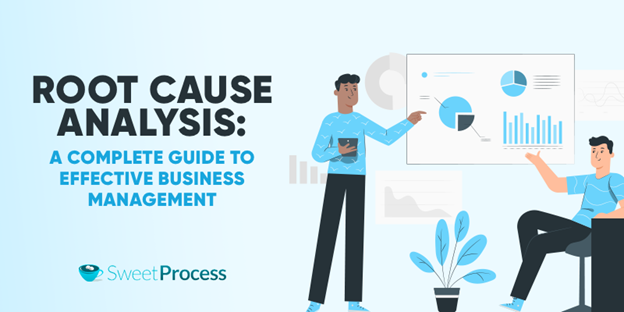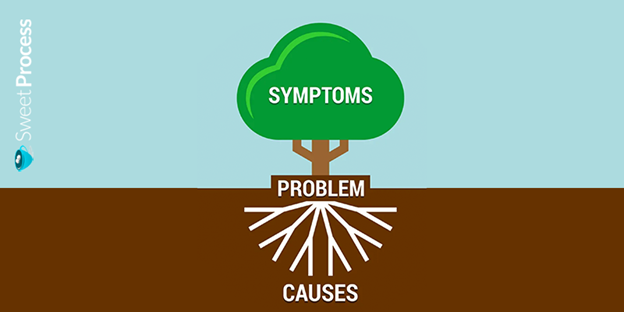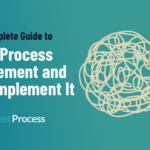Root Cause Analysis: A Complete Guide to Effective Business Management
Last Updated on May 21, 2024 by Owen McGab Enaohwo

Think about the last major problem your business encountered. Did you take the time to discover the actual underlying cause or did you implement a quick fix that dealt with the symptoms?
Every business goes through its fair share of issues that can be challenging to resolve. In these situations, it’s important to identify and fix the problem, and not just the problem’s symptoms.
Problem-solving is a daily task in any business. But what to do when significant problems keep coming back? If you feel like you are constantly putting out fires in your business, it may be because the underlying causes of the most critical problems are not being addressed in a structured way.
Root Cause Analysis Table of Contents
Chapter 1: Introduction to Root Cause Analysis
Chapter 2: Effectiveness of Root Cause Analysis
Chapter 3: How to Perform a Root Cause Analysis
Chapter 4: Root Cause Analysis: Challenges & Benefits
Chapter 5: Limitations of Root Cause Analysis Processes
Chapter 6: Tools for Performing Root Cause Analysis
Chapter 7: Steps to Performing a Trouble-Free Root Cause Analysis
Chapter 8: How SweetProcess Can Make Your Root Cause Analysis Process Seamless
Chapter 1: Introduction to Root Cause Analysis

When you are sick, you go to see a doctor who can diagnose the illness’s fundamental cause.
When your car breaks down, you might seek the assistance of a mechanic to determine the source of the issue. As a business owner, project manager, or team leader, you need to determine why a specific company’s area of performance is falling short (or exceeding expectations).
In each of these examples, you can look for a simple solution for each symptom. When you get sick at work, you can work at home. To get around, you can leave the broken-down car in the garage and take a bus.
However, these solutions only treat the symptoms. They do not address the causes behind them: a stomach infection that requires medication, or a faulty alternator that needs to be fixed. To investigate or resolve a problem, you need to perform a root cause analysis to determine the exact cause and how to resolve it.
In this context, we’ll define root cause analysis, describe common techniques, explore a reference methodology, and present some examples.
History of Root Cause Analysis
RCA is a systematic and scientific approach to determining the root cause of a problem. Once the root of a problem is discovered, it is possible to find a truly effective solution that will prevent the problem from happening again instead of merely addressing its current effects.
RCA assumes that it is more beneficial to systematically prevent and resolve underlying issues than simply treating specific symptoms and putting out fires.
RCA can be done with a set of principles, techniques, and methodologies that allow you to identify the root cause of an event or trend. RCA can show where processes or systems have failed or caused a problem beyond a superficial cause-and-effect check.
Goals of Root Cause Analysis
- As its name implies, the primary purpose of an RCA is to discover the root cause of a problem or event.
- The second goal is to fully understand how to fix, compensate, or learn from any underlying issues within the root cause.
- The final goal is to apply everything learned from analysis to avoid future problems or systematically repeat something that went right.
An analysis is only valid when we practice what it teaches us, so the third objective of RCA is important. You can also use RCA to adjust processes and systems to avoid future problems. When a football player is injured, RCA may suggest wearing a helmet to reduce the risk of future injury rather than just treating the symptoms.
By treating the individual symptoms, we can feel that everything is under control. When solving many problems, we can feel a sense of accomplishment. However, if we don’t diagnose the root cause of the problem, it will likely keep repeating itself.
Principles of Root Cause Analysis
Some basic principles help ensure the effectiveness of RCA. In addition to contributing to the quality of the analysis, these principles will also help the analyst gain the trust and support of co-workers, clients, or patients.
Before beginning an RCA, you should be clear about the following basic principles:
- Recognizing and treating symptoms alleviates problems, but only in the short term.
- It is necessary to focus on correcting and remedying their root causes to resolve them definitively and act so that they do not happen again.
- There can often be multiple root causes for the same problem.
- The most important thing is to determine how and why something happened, not who was responsible.
- One must be methodical in finding the concrete cause-effect evidence to support the respective root cause claims.
- Sufficient information must be provided to determine a corrective action plan.
- The necessary conclusions need to be adopted on how to prevent a root cause in the future.
These principles demonstrate that an accurate analysis of problems and root causes requires an integral and holistic focus. When discovering the root cause, we must strive to provide the context and information necessary to take any action or make a corresponding decision.
In other words, it is always necessary to remember that good analysis can be acted upon.
Chapter 2: Effectiveness of Root Cause Analysis

The simplest way to justify an RCA is by solving common problems. A first approach is to take cases from everyday life as a reference. Here are some of the products of an effective RCA:
- Quick detection of errors and corresponding systemic changes
- Deeper insight into root causes
- Safer working environment
- Better organization
Quick detection of errors and systemic changes
A classic report, for example, documented a patient who underwent a heart operation planned for another patient with the same name. A typical investigation might have concentrated on apportioning blame to specific individuals, such as the nurse who sent the patient for the treatment despite the lack of a consent form.
The subsequent RCA, on the other hand, revealed 17 errors ranging from organizational factors (the cardiology department used a homegrown, error-prone scheduling system that identified patients by name rather than medical record number) to work environment factors.
As a result, the hospital implemented a number of systematic changes in order to lessen the likelihood of a future error.
Deeper insight into root causes
For example, in a factory it is noticed that employees are not managing to handle a certain tool properly. At first, one can imagine this happening due to the workers’ inattention. So the culprits are elected.
Likewise, we can design this scheme for a company or organization. If the organization has a problem with poor performance in a specific area, we must try to check the root cause of this problem to solve it and avoid it so that it doesn’t happen again.
However, if the pattern repeats itself, there may be an underlying cause behind this error. Is the equipment properly calibrated? Could it be that employees were not trained in the right way? In these cases, it is necessary to find the root cause.
In theory it sounds easy; however, the RCA requires problem solvers to go beyond the superficial and immediate, because the first symptoms of a problem cannot be remedied without knowing its root cause and the most appropriate solution for it.
Safer working environment
Sometimes there is a need to act quickly to allow others to go about their day-to-day work. Thus, when faced with some variability, many companies do not investigate it. They only treat the symptom. When we don’t address company failures, situations can get even worse. In this sense, something that was a small mistake can become an incident, putting the safety of a worker or customer at risk.
The company needs to break the production routine when an unforeseen event arises. The need to spend time and energy solving small variations is also important for the continuous improvement of processes and ensuring a safer work environment.
Better organization
In order to deeply analyze the problem or contingency affecting our organization and thus obtain the relevant lessons, we must find out exactly what its cause is and how to solve it.
Resolving defects in a process is an opportunity to improve the organization. Through the search for continuous improvement, better results can be achieved than the previous ones.
Chapter 3: How to Perform a Root Cause Analysis

Problem-solving is an everyday task in any business. But what to do when major problems keep coming back? If you feel like you are always putting out fires in your business, it may be because the underlying causes of the most important problems are not being addressed in a structured way.
Follow these five structured problem-solving processes to remove pitfalls once and for all.
1. Define the event
Define the event in detail. For example, it is not enough to say that the problem with your business is that customers are unhappy. Point out that clients do not like the slow turnaround times and that their satisfaction has decreased by 30 percent compared to last year.
The six questions below should help you describe your operational issues.
- Does the problem occur constantly or only occasionally?
- When is the problem occurring?
- Where is the problem occurring?
- What are the processes, products or parts involved?
- What has changed lately? Are there new players?
- Who does this problem affect, or who needs to be informed?
2. Find the root cause
Finding the underlying causes of problems is essential to developing the appropriate solutions. A simple problem can be tackled using the “why” approach, which involves asking “why” at least five times to find the source of the problem. For example: “Why are couples not using modern contraceptive methods?” Root causes are seldom found in the most obvious causes.
The whys approach helps you question the root causes of an event or situation. This analysis is usually done by asking five fundamental questions. At the end of the day, the individual ends up with a true assertion of root causes and makes positive steps to resolving them.
3. Find solutions
When the root causes of the problem are understood, engage your team in brainstorming solutions. Be sure to consider how the solutions will affect all business areas.
4. Make plans
With your team, define an action plan to implement the solutions. The plan should detail the initiatives, indicate who is responsible for their implementation, and contain a timeline. It should also include key performance indicators (KPIs) to measure the impact on the business.
5. Verify effectiveness
It is important to follow up with your team to ensure the corrective actions have been implemented and monitor any improvements to assess the impact of the solutions on your business. Additionally, be prepared to adjust your action plan as needed and consider any discrepancies between desired and actual results.
If turnaround times decrease and customers get your product faster, you might have resolved your customer satisfaction issue. If not, you may need to examine the process to find other root causes or solutions.
Chapter 4: RCA Challenges & Benefits

Challenges
Typical RCA applications include failure to deliver a product or service, receiving negative customer feedback, experiencing a sudden drop in productivity, or unplanned disruption. RCA often takes a significant amount of time to perform, leaving some managers hesitant to employ it.
Limitation of technique: Sometimes using tools like the five whys oversimplifies the timeline of events, and you don’t get a clear picture of all the root causes that led to the problem.
Team building: Poorly assembled and inadequate teams can make effective analysis difficult. Consider, for example, teams with people with difficult personalities (dominant, for example) and with limited skill sets.
Lack of a culture of support for problem-solving: When action plans arising from the analyses are not implemented due to lack of support/interest from the organization, it may not make sense to carry out a good root cause analysis.
Wrong focus: In many cases, cause analysis is confused with an exercise in finding blame rather than seeing it as a learning opportunity.
Too many participants: Involving too many people can lead to a lack of focus on the issue at hand.
Cost of solutions: If the proposed solution(s) are too expensive, the root cause analysis will prove fruitless.
Resistance: The proposed solution(s) can also be rejected by those impacted by it, as this means a change in routine, skills, etc.
Inadequate facilitation: Analysis can be hampered if the facilitator lacks the experience and communication skills necessary to lead this step-by-step guide.
An RCA is a tremendously effective way to understand the drivers of issues in your process and business.
Benefits
Here are some of the reasons why applying this technique is beneficial despite its time-consuming activities:
It deals with the real problem.
If companies rush to find solutions without first identifying the source of a problem, this leads to increased waste and possible new problems.
Bring the team together.
Investigating the root cause of an issue can foster unity among team members, often with differing opinions about why an issue occurs. Through qualitative and quantitative data, the root cause analysis must show the real reasons a problem or defect occurs, helping to establish the objective consent of all interested parties.
Ensures the solution is maintained.
The measure of success is not whether you have a difficult problem to solve, but whether this is the same problem you had last year. Root cause analysis enables you to involve the team to determine the cause of an issue and ensure that the obstacle doesn’t reappear. Root cause analysis helps develop solution ownership.
Facilitates in-depth communication and learning.
Retrospectives are an efficient means of gathering information for root cause analysis. Getting your team to solve a persistent problem will unite them and drive improvement beyond the scope of the initial difficulty.
Chapter 5: Limitations of Root Cause Analysis

There are different opinions about some possible limitations of the RCA.
So that you can analyze how these disadvantages can be reflected in your company, let’s list the main ones now:
- Sometimes the effort is wasted on identifying causes that have little real effect on the problem.
- It is based on opinion and not evidence. Thus, the process involves a democratic way of selecting the cause—that is, voting on the causes which may not be an effective means of properly identifying them.
- If the discussion is not adequately controlled, it can stray from its central objective.
- As it only assesses events that have already occurred and are purely qualitative, it is not appropriate to make a risk assessment.
- You are dependent on your team’s knowledge to determine the cause quickly. If an unexpected failure mode occurs, you may never conclude.
- It is not always easy to distinguish the “symptoms” from the “causes” and decide when to stop. Occasionally, you might end the analysis before running a deep and exhaustive analysis.
- Your team has a biased view, so it may create biased questions and answers that confirm your suspicions or theories. The lack of exemption can compromise the analysis results.
For these reasons, different teams can reach different results from the same damage or question.
It is noteworthy that the success of applying the RCA in your company depends on how you will develop it and on your team’s level of understanding and participation.
If the participant has less experience, less involvement, and less knowledge, their diagram tends to be vague and incomplete.
So you might not identify the root cause of the problem, which is the big goal here.
Therefore, involve experienced experts, and explore and try to answer as many questions as necessary to ensure the successful application of this interesting tool.
Chapter 6: Tools for Performing Root Cause Analysis

We can use many tools for RCA, and undoubtedly there are many more besides those mentioned here. Next, we’ll cover some of the most common and effective tools.
Pareto Chart
The Pareto chart is one of the seven basic quality tools to focus on improvement efforts. In this tool, the frequencies of each cause are represented similarly to a histogram, but in descending order by bars, and the accumulated total is represented by a line.
For example, a Pareto chart can be viewed as a team working on their supplier’s delivery performance. Finding that the suppliers themselves needed to make changes to their systems to improve on-time delivery, they realized that it would be necessary to train each of them. However, as they had 4,000 suppliers, this seemed like an impossible task.
To accomplish the task which was initially considered impossible, the team focused its improvement efforts on the few significant causes. Rather than thinking about 4,000 suppliers, each purchasing agent worked with a few but the most significant suppliers each month, so on-time delivery performance was established as part of that focused effort.
This Pareto analysis is based on a customer point of view: how often has the customer been inconvenienced due to a late delivery? (Note that, from a supplier’s perspective, the percentage of on-time deliveries would be a more appropriate measure.)
The Five Whys
The five whys is a method of exploring cause-and-effect relationships. Thus, this technique is used as part of a root cause analysis to find ways to avoid future incidents. When applied to recent near misses, it can help prevent future events from turning into complete disasters.
Therefore, the five whys technique helps researchers and analysts determine the root cause of a problem by repeatedly asking “Why?” Researchers are urged to use deduction to focus on processes rather than behavior, avoid jumping to conclusions, and focus on causes, not symptoms.
So how does it work?
It’s very simple, they just have to start from an observation, and ask yourself the question “why” five times?
Let us take a concrete example: For a car breakdown, we need to ask five questions to understand the root cause of the problem.
1. Why a breakdown? Because the battery is dead.
2. Why is the battery dead? Because you forgot to turn off the headlights for several days.
3. Why did you forget to turn off the headlights? Because your mind was busy and you forgot.
4. Why has your mind been busier lately? You have worries at work that you think about all the time.
5. Why do you have problems at work? You have accepted additional tasks when you were already overwhelmed with work.
In the above example, you have two problems:
- You have worries that developed the habit of forgetting to turn off your car’s headlights.
- Accepting additional tasks at work when your schedule is already full stresses you out and impacts the quality of your life.
To solve the problem in the short term, you need to change the battery.
But to correct the problem in depth, it is important that you speak to your supervisor and agree on your workload.
The five whys technique therefore makes it possible to find the root causes of a problem and to put in place truly effective solutions.
Fishbone Diagram
Also known as the cause-and-effect diagram, a fishbone diagram is a quality tool that identifies many possible causes for an effect or problem. It helps managers track the reasons for imperfections, variations, defects or failures. On the other hand, this diagram is also used to structure a brainstorming session.
The diagram looks like a fish skeleton where the main problem is located in its head. For example, in the case of a car where we often need to fill it up, the main problem is the high fuel consumption, and it is this problem that takes the place of the fish’s head.
However, the causes of the problem are divided into macro causes and micro causes. Macro causes, also called major causes, can be further divided into smaller ones. Following the example of high fuel consumption, one of the macro causes may be related to the material, unfolding the type of fuel as a micro cause.
To define macro causes, there is a technique that is called 6M:
- Machine
- Material
- Labor
- Measurement
- Environment
- Method
Once the macro causes are defined, they are subdivided into smaller causes. Once all the underlying causes are identified, managers can look for solutions to ensure the problem does not recur.
Scatter diagram
A scatter plot is used to show the relationship between two types of data. It can be the relationship between a cause and an effect, between one cause and another, or even between one cause and two others.
If a relationship is identified, then the possibility arises that the variation of the other variable can control one variable.
The data is displayed as a collection of points, each with the value of one variable determining the position on the horizontal axis and the value of the other variable determining the position on the vertical axis (in the case of two variables).
Failure Mode & Effect Analysis
Failure mode and effect analysis (FMEA) is one of the most complex tools to perform root cause analysis and one of the most appropriate for maintenance and facility management. This is an analysis that answers the “what if…” question, that is, (1) what is the probability of a particular failure occurring and (2) if it does, what effects does it have?
FMEA analysis goes hand in hand with asset criticality analysis (in this case, it is called FMECA), although it can also be used with other tools in this list, such as the fault tree. It is an appropriate root cause analysis tool to assess the impact of failures, draw up contingency plans, establish cause-effect relationships, and plan improvement actions or scheduled corrective maintenance.
However, describing all failure modes takes time and effort. It is more common in highly critical assets, industrial maintenance, and sectors with high-security risks.
There are many ways to find the causes of a problem, even if you face a particularly complex situation with many possible solutions.
If the issue is not included in the FMEA, the team should add known information and then complete the following steps:
- List the current problem as a mode of failure of the design or process.
- Identify the impact of the failure by defining the severity of the problem or the effect of the failure.
- List all the probable causes and how often they occur.
- When examining an FMEA process, examine the process flow or process diagram to help locate the root cause.
- Next, identify the escape point, which is the closest point in the process where the root cause could have been detected, but was not.
- Document the controls in place designed to prevent or detect the problem.
- List any additional steps that could be taken to prevent this issue from recurring and assign an owner and due date for each recommended action.
- Carry out all the corrective actions or measures identified during the RCA activity.
It is important to choose the right technique depending on what you want to do: find an effective, fast, deep, or concrete solution.
Chapter 7: Steps for Trouble-Free Root Cause Analysis

RCA is a specific technique that you can use to troubleshoot problems. With it, you analyze the problem using a specific set of steps to find the root cause. RCA is based on the principle that it is useless to pay attention to the symptoms of a problem if you ignore its root.
With RCA, you can figure out what happened. It is often not possible to get the full picture just by observing the symptoms. Knowing what happened is only the first step. Then you need to go further and reveal the cause of what happened. Armed with this knowledge, it’s time to put it into practice and formulate a plan or strategy to avoid repeated mistakes.
Here are four tips to help you troubleshoot RCA problems.
Use the duckling method
In the duckling method, the aim is to explain your problem to a rubber duck. No duckling at hand? Do not worry! You can use any inanimate object that comes close, or talk to another person.
What is the duckling method? This method is based on the fact that when you explain something to someone, you are simultaneously organizing the thoughts in your head. Our thought process is often chaotic. When we are faced with an inevitable explanation, we involuntarily put everything on the shelves.
Will the duckling method be enough to fix any problem? Of course not. It may be enough, but usually it is only the first step in a large-scale strategy.
Are you afraid people will think you are a little weird talking to inanimate objects? Well, the point is, the whole rubber duck idea is a joke. This is a silly and memorable image that should not be taken too seriously. The important thing is that you force yourself to express thoughts in a more orderly manner and explain the problem more clearly.
You can use the following methods:
1. Post a question on Stack Overflow. Or pretend to be writing a Stack Overflow question, but use notepad instead.
2. Make a detailed error report. Someone will have to do it anyway, so why not kill two birds with one stone?
3. Go to your colleague’s office and talk for a few minutes. Of course, only if they don’t mind. Don’t disturb your colleagues unnecessarily.
Collect log data (and do an effective search)
If you’ve successfully and clearly explained the problem but still can’t get to the root cause, then you need to move on. What is required now is to collect all the information about the problem and extract analytical conclusions.
This is where logging and monitoring come in handy: crash logs, application and server logs, and whatever else you have. Evidence of the problem should be collected and, if possible, investigated for how long and how often the problem has occurred.
Although you can go further, collecting a lot of data is important, but it won’t do much if you can’t find the pieces of information you need quickly. A needle in a haystack situation is neither enjoyable nor particularly productive.
That’s why it’s imperative to use tools that allow you to search and analyze all of the log data you’ve collected in real-time and turn it into valuable insights that you can use to diagnose and resolve problems faster.
Use the five whys technique
After collecting the information, it’s time to use it and find the causal factors. “Causal factor” here refers to the immediate cause of the problem in question. You shouldn’t identify one cause and effect factor and then stop. You need to look deeper. One of the best-known techniques for this is the “five whys” method.
Its essence is to continually ask the question “why?” until you get to the root of the problem. Let’s look at a small example.
Problem: The website displays a 500 error.
1. Why? Because the web platform router is out of order.
2. Why? Because it needs another component to work, which is also defective.
3. Why? Because this web platform component requires an intl extension, which doesn’t work.
4. Why? Because it was accidentally disabled after a server software update.
As you can see, five is just a rough number. You can get to the main problem in fewer steps or more.
The five whys method is far from perfect. It has received its fair share of criticism, and it certainly has limitations. But it can be useful for nudging engineers to find the root cause instead of stopping at the first sign of a solution.
Find an extra pair of eyes
One practice we have learned is code review. It’s amazing how just a fresh look from an unbiased person can reveal many code problems that you might not have noticed before. Over time, expecting the other person to look at your work will make you feel more conscious. It can also help you pay better attention.
So with that in mind, would we recommend doing a code review? Sure, yes, but that’s not the only way to get an extra pair of eyes. Use walking review processes for almost every engineer’s task. Better yet, a couple. Perform paired programming, paired server setup, paired debugging, and paired client support. In short: solve problems together.
Removing defects is such that it can be called an art rather than a science. But this should not prevent you from using methods and tools to work more efficiently.
Apply these techniques to root cause analysis:
1. Use the duckling method.
2. Collect a lot of log data, search it, and analyze it with the right tools.
3. Use the five whys technique.
4. Find an extra pair of eyes.
It’s time to grab the rubber duck and start analyzing the root causes of your problems.
Others
There are some other basic principles that guide effective root cause analysis, some of which should already be apparent. This will not only help the quality of the analysis, but it will also help the analyst to gain trust and buy-in from stakeholders, customers or patients.
Focus on correcting and remediating the root causes, not just the symptoms. The most common thing for people using root cause analysis is to find some problems and be satisfied that they have found the root of the problem. This is often not true—they are just symptoms.
Do not ignore the importance of treating symptoms for short-term relief. The goal is to find the root cause, but it’s not a bad idea to solve some bad symptoms that are latent for your company/team.
Realize that there can be, and usually are, several root causes. It’s not common, but sometimes you’ll find more than one root cause. In this case, solve them one at a time, and don’t forget to measure the impact of each one on the process.
Focus on HOW and WHY something happened, not WHO was responsible. The aim of the method is to find the problem and solve it, so don’t make the exercise a witch hunt. By doing this, you create a toxic and distrustful atmosphere in your team, inhibiting future improvements.
Be methodical and find hard evidence of cause and effect to support root cause claims. What you need is to provide enough information to inform a data-based corrective course of action, never guesswork.
Work as a team and get new eyes. Getting other people’s opinions will also provide additional insights, helping us to challenge our assumptions.
Plan for future root cause analysis. Take notes. Find out if a particular technique or method works best for your specific business environment and needs.
Remember to perform root cause analysis for successes as well. Root cause analysis is a great tool to find out where something went wrong. But it can be just as effective in finding the root cause of a success.
As the above principles illustrate, when analyzing problems and root causes, it is important to take a comprehensive and holistic approach. We must aim to provide context and knowledge that will lead to an action or choice and uncover the root cause.
Remember: good analytics is actionable analytics.
Chapter 8: How SweetProcess Can Make Your Root Cause Analysis Process Seamless

SweetProcess can make creating your RCA process easy and straightforward. Take a look at the following real-life case studies to see how you can transform your business.
ShipCalm
The CEO of ShipCalm, Ted Fogliani, has always been process-driven. ShipCalm is an e-commerce-focused logistics company. It offers fulfillment services via an omnichannel, shipping directly to consumers and retailers.
As a third-party logistics company, the organization stores products in a warehouse and ships them to consumers who order them as soon as possible. It channels its software systems and employees toward enhancing the customer experience.
When Ted first started ShipCalm, he wanted to streamline the company’s operations, but all of the solutions he found didn’t match his expectations. They were lacking in one or more areas. His employees’ efficiency was also affected by the lack of an effective RCA system, as they had insufficient knowledge to accomplish jobs.
However, Ted’s team suffered their first setback last week. Ted gained an opportunity to ship some goods from his warehouse to a customer.
This was the first huge project Ted had gotten after reaching out to many clients.
The team was ecstatic and set right to work, planning and scheduling every detail of the project.
Unfortunately, the team’s delivery man fell ill in the middle of the project and missed a week of work. Other staff attempted to fill in the gaps, but items fell through the cracks.
The team failed to deliver the goods at the required deadline. When the sick delivery man was finally ready to return, they were so near to their deadline that he had to speed through it, overlooking a few key items that the customer had requested.
As you might expect, Ted lost the deal and his relationship with the client is unlikely to improve.
To add insult to injury, the company was under tension as the customer gave a bad review. Ted was frustrated because he had ensured the team was briefed about the importance of the project.
What went wrong?
Ted continued to search for the right system, and when he found SweetProcess, he knew that was what he needed. He tells us how SweetProcess was able to analyze the RCA problem effectively and get adequate solutions for facilitated growth and employee efficiency in his company.
Choosing SweetProcess as the Best Option
What did Ted do?
Ted committed to working with SweetProcess. This experience has taught him that he has a lot to learn about managing both projects and teams. He’s resolved to keep working with SweetProcess to seek the help he needs to improve.
With SweetProcess, Ted was able to analyze their business processes to identify the causes of the setbacks the team had experienced. He soon discovered several loopholes that were left unattended. Other members of the team had tried to fill the gap created by the ill staff but they weren’t organized about it. They still had to juggle the extra tasks while trying to meet up with their personal deadlines. In the end, they had too much on their plates to see the tasks omitted.
With a detailed organizational process, Ted was able to draft a new strategy for executing tasks and due monitoring to ensure it was well executed.
The new improvements were made because Ted subscribed to a new process manual template from SweetProcess. This showed him how best his operations could be executed.
How TechQuarters Overcame RCA Problems by Creating Effective Business RCA Processes
TechQuarters’s CEO Chris Dunning and Operations Director Mark O’Dell are committed to helping small- to medium-sized businesses leverage opportunities in the cloud. With over a decade of experience under their belts, they have mastered the art of planning, moving, supporting, and training users as they migrate their IT online.
But it wasn’t always so easy.
As their business began to grow, they realized that assumption was causing more harm than good to their organization. It was a no-brainer that they would achieve better results if they had all their great RCA business processes.
In their search for the right RCA process for their business, they found SweetProcess. Not only were they able to analyze the root cause problems, but they were also able to create solutions that scaled their business.
About TechQuarters
TechQuarters is an IT company that helps businesses take advantage of cloud solutions to meet their IT needs.
A leading supplier of Microsoft Solutions, one of its core products is Microsoft Cloud Solutions. TechQuarters guides businesses on how to use each function of cloud technology to their benefit with well-crafted training solutions and a dedicated customer support team on the ground.
Rather than offering this service from a top-bottom position, the company levels up with businesses to better understand their services and works with them to achieve their goals.
Based in London, the company currently has over 43 employees.
The Biggest Pain Point
Every startup hopes to grow. But in the absence of a strong system to manage that growth, it becomes a pain in the neck. Each process needs to be taught over and over again as new employees are onboarded.
Being able to analyze root cause analysis people was a challenge.
The team at TechQuarters had first-hand experience of this. As Mark reveals, it was one of their biggest pain points.
“Growth and scalability are something that we’ve had to deal with. And I suppose all small companies, as they grow, do. We’ve grown every year, year on year, you know, in terms of revenue and staff, and doing so brings challenges. From being a few people sitting next to each other with a few customers that you all know to one new person becoming ten new people.”
With more customers to cater to, TechQuarters found that they didn’t know what to include in their root cause analysis process.
They needed a checklist to help them create an exceptional root cause analysis process.
Choosing SweetProcess as the Best Option
The many moving pieces in their operations pointed to a need for an RCA process tool. As the operations director, Mark took it upon himself to find the best offer on the market. He used Google to search for an RCA process that would give him many options, and after sampling a few, he knew that SweetProcess was the one.
The flexibility of SweetProcess was hard to ignore. SweetProcess gives you the opportunity to analyze your root cause analysis problem effectively and get adequate solutions for better operations. So click here to let us help you achieve better RCA results.
Conclusion
Prior to this point, we have seen how the RCA process is essential to scaling up your business activity or operation. A better understanding of root causes increases your productivity and gives you a different approach to handling operational challenges.
Now that you know so much about how to analyze the root causes of a problem and how to prioritize solutions, download the content upgrade: a must-have checklist to help you create an exceptional RCA process.
Give SweetProcess a try and watch your business get revolutionized. We have a 14-day trial window to give you a taste of the benefits of service. Click here to get started.










Leave a Reply